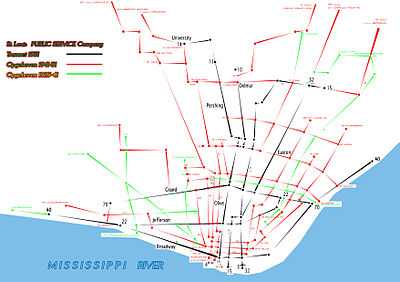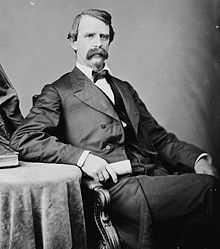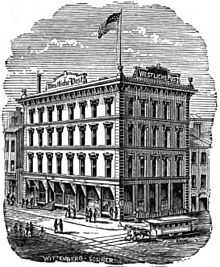Streetcars in St. Louis

Streetcars in St. Louis, Missouri operated as part of the transportation network of St. Louis from the middle of the 19th century through the early 1960s. During the first forty years of the streetcar in the city, a variety of private companies operated several dozen lines; from the start of the 20th century, most of these companies consolidated into the St. Louis Public Service Company, which served both the city of St. Louis and neighboring St. Louis County, Missouri. Other private companies, such as those serving the Metro East region or St. Charles, Missouri, continued separate operations. Starting in the 1930s and continuing through the 1960s, St. Louis Public Service ended all streetcar service, while other regional operators also ended their services.
Historical streetcar service

Early public transit
By the 1830s, the city of St. Louis had grown in size beyond the ability of many of its residents to walk conveniently throughout the town.[1] In 1838, brief mention is made in historical records of a private horse drawn cab service in the city, followed in 1843 by the beginning of an omnibus service by entrepreneur Erastus Wells in partnership with an investor named Calvin Case.[1] During the late 1840s, other horse-drawn omnibus service companies began operation, but by the end of 1850, most of these companies had consolidated with the Case and Wells lines to form Case and Company, which operated 90 carriages and several lines in the city.[2] In 1855, principal investor Case was killed in the Gasconade Bridge train disaster, and the company was divided among its other investors.[2] The resulting horse-drawn tram lines became the blueprint for street railway service in the late 1850s.[2]
Initial street railways

In December 1855, a group of investors formed the Laclede Railway Company for the purpose of building a street railway, modeled on services then provided in eastern cities such as New York City, Philadelphia, and Boston.[3] However, the Laclede line was never built. In spite of the early failure, by 1859, seven other lines were proposed; however, only four were completed before the outbreak of the American Civil War.[4] The first of these lines began operation on July 4, 1859, running east to west on Olive Street from 4th to 10th streets.[5] However, early operations were marred by difficulty in securing quality rails, and construction problems caused derailments of the cars.[5] All of the prewar railways used horse power to pull their cars, that is they were Horsecars.[6]
After the Civil War, other lines opened in St. Louis that connected the central city with western areas.[6] In 1874, with the opening of the Eads Bridge, a new line opened connecting the city with East St. Louis, Illinois.[6] The first experiments with mechanical traction for the cars took place immediately after the war in 1865 on Grand Avenue, while a fully operational steam-powered line opened in 1868 as an extension of the Olive Street line.[6] This line, however, was not operationally connected with the rest of the horse-drawn lines, and it used a different track gauge than other lines.[7]
Decline
In the 1920s streetcars began to be replaced by motor buses as bus operators could route freely over public streets, paying only vehicle and gas taxes, while streetcar operators had fixed routes by the tracks, and had to pay additional property taxes for the infrastructure they placed in the road, however a good transit route doesn't need to change often. The construction of Highway I-70 that cut through downtown St. Louis, threatened and ended service to many street lines. The last St. Louis streetcar route in operation was the 15 Hodiamont line which ceased service on May 21, 1966. Much of the streetcar systems' routes are today's MetroBus and Madison County Transit bus routes. St. Louis was also involved in the Great American streetcar scandal.
Streetcar builders
The St. Louis Car Company began operation in 1887 when financier J.H. Kobush and plant supervisor Peter Kling abandoned the German immigrant industrialist Frederick Brownell's streetcar manufacturing company. The company lasted until 1973, was located at 3023 North Broadway, and took orders from across the country. The St. Louis Car Company became the biggest streetcar builder in the world. They distributed their cars internationally at their height.
Historical lines or companies
- Baden and St. Louis Railroad
- Benton and Bellefontaine Railroad
- Citizens Railway
- Cass Avenue and Fairgrounds Railroad
- Forest Park and Clayton Railroad
- Lindell Railroad
- Midland Street Railway
- Missouri Railroad
- Northern Central Railroad
- Peoples Railway Company
- St. Louis and Kirkwood Railway
- St. Louis and Suburban Railway
- St. Louis Railroad
- St. Louis, St. Charles and Western Railway
- St. Louis Public Service Company
- Southern Electric Railway
- Tower Grove and Lafayette Railway Company
- Union Railroad
- Union Depot Railroad
- Belleville Electric Railway Company
- East St. Louis and Suburban Railway Company
- East St. Louis Railway Company
- Illinois Traction Company
- Alton, Jacksonville and Peoria Railway Company
- East St. Louis, Columbia and Waterloo Railway Company
These cars serviced 70 Grand, 20 Cherokee, 22 Jefferson, 40 Broadway, 13 Union, 03 Midland, 01 Kirkwood/Ferguson, 10 Delmar, 15 Hodiamont, 42 Sarah, 53 Chouteau, 32 Wellston, 31 Natural Bridge, 05 Creve Coeur Lake, 53/54/55/56 Manchester, 12 Maryland/Olive, 11 University, 14 University Clayton, 66 St. Peters, 65 Woodson, 67 Bridgeton and 51 Forest Park. St. Louis Public Service sold 1700 series to the San Francisco Municipal Railway in 1957. Their numbers were changed to the 1100 series and ran until their retirement in 1982.
Fleets
St. Louis ran Peter Witt Streetcars from 1927 to 1951. All of St. Louis's 3 series of Peter Witt cars were built in the United Railways' (predecessor to St. Louis Public Service Company) 39th St shops. Later art-deco PCC (Presidents Conference Committee) cars were first produced in 1936. They were 46 feet long and 9 feet wide. They sat 53 passengers. The St. Louis Car Company built many of these models. St. Louis Public Service Company ordered three groups of PCC cars in the 1500, 1600 and 1700 Series from them. The first group was delivered in 1940; the last group was delivered in 1946.
Revival
There are three current projects for streetcars in St. Louis.
Delmar Loop Trolley
The Delmar Loop Trolley is a 2.2-mile (3.5 km) proposed heritage trolley line that is planned to serve the Delmar Loop district in St. Louis, Missouri and University City, Missouri. The line will have about 10 stations and serve the Missouri History Museum in Forest Park, Washington University in St. Louis, two MetroLink stations; Forest Park-DeBaliviere station and Delmar Loop station, University City City Hall, and all the Delmar Loop attractions.
Origin
The Delmar Loop got its name from a loop of track on the 10 Delmar Streetcar line, which ran its last trip on April 19, 1964.[8] In the early 20th century, the Loop was adjacent to the Delmar Gardens Amusement Park.[8] Until its abandonment on July 25, 1950, the loop was also the terminus of the 05 Creve Coeur Lake line famous for its open "moonlight" cars. The Loop long retained its name, and found a champion in Joe Edwards, the owner of Blueberry Hill, The Pageant, and a number of other Loop businesses. Edwards secured the purchase of two restored Peter Witt-type streetcars that once operated in Milan, Italy, and has led the initiative for a new line in conjunction with Citizens for Modern Transit.
Fleet
The two Peter Witt cars were refurbished by the Gomaco Trolley Company in 2005 and placed on long-term display along the route—one on Delmar by Commerce Bank, and the other at the History Museum. Not conforming to ADA regulations, the cars will remain parked until they can be modified. The Loop Trolley line is planned to be served initially by a fleet of three streetcars: two Gomaco-built Brill-replica streetcars which until 2014 were used on the Portland Vintage Trolley service (in Portland, Oregon)[9] and one of the two red Peter Witt streetcars. The three cars are scheduled to be modified for wheelchair accessibility.
St. Charles City Streetcar
The nine original 1700 series PCC streetcars were purchased for use in New Town at St. Charles by Whittaker Builders Inc. Some will be placed around town converted into old-fashioned diners, cafés, or bookstores while others will be restored and put back in service. The proposed route is said to be 8-mile (13 km) from New Town to St. Charles, Missouri.
St. Louis Streetcar
In June 2013 Forbes magazine profiled new streetcar systems of ten USA cities that had built or were building new modern streetcar systems.[10] According to Forbes St. Louis is planning to build a 7-mile (11 km) modern system to connect Downtown St. Louis to the Central West End along with other neighborhoods like Downtown West, Midtown, and Carr Square. It does not connect to the Delmar Loop Trolley.
See also
- List of streetcar systems in the United States
- Streetcar strikes in the United States
- Streetcars in North America
References
- ↑ 1.0 1.1 Young (1988), 9.
- ↑ 2.0 2.1 2.2 Young (1988), 11.
- ↑ Young (1988), 12.
- ↑ Young (1988), 13.
- ↑ 5.0 5.1 Young (1988), 14.
- ↑ 6.0 6.1 6.2 6.3 Young (1988), 26.
- ↑ Young (1988), 27.
- ↑ 8.0 8.1 St. Louis Streetcar Story, Andrew D. Young, Interurban Press, 1987
- ↑ Bowen, Douglas John (December 13, 2013). "TriMet sells heritage trolleys to St. Louis". Railway Age. Retrieved September 28, 2014.
- ↑ "Will St. Louis Be Home To The Trolley Once More?". Forbes magazine. June 2013. Retrieved 2013-06-27.
Its backers want a new system to connect downtown, Carr Square, and a series of neighborhoods.
External links
- Western Rail Images Website
- KETC Living St. Louis Streetcar Memories a short video about streetcars in St. Louis, with various 20th century footage assembled by local PBS station KETC
| ||||||||||||||||||||||||||||||||||||||||||||||